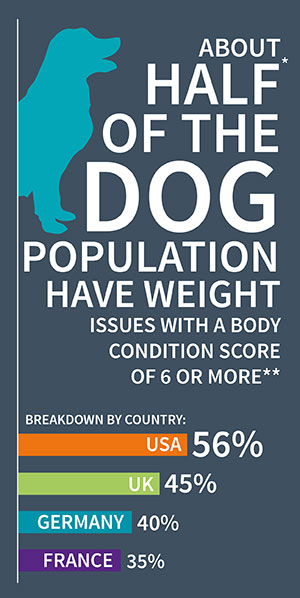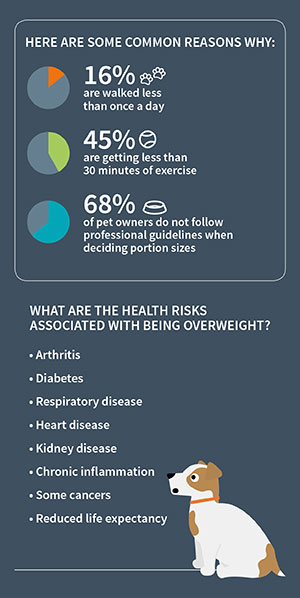Why a healthy weight is important for your dog
20th November 2019
If your dog maintains a healthy weight, it will help them to lead a happy, healthy lifestyle with a better chance of avoiding potentially life-threatening illnesses linked to obesity.
* 56% in US (https://petobesityprevention.org/2017), 45 % in UK (https://www.pfma.org.uk/news/pfma-releases-pet-obesity-report-five-years-on), 40 % in DE (Studie der Ludwig-Maximilians-Universität München)
** https://www.wsava.org/WSAVA/media/PDF_old/Body-condition-score-chart-dogs.pdf
Other resources: https://www.pdsa.org.uk/media/3291/pdsa-paw-report-2017_printable-1.pdf
Is my dog overweight?
Not everyone is aware that their dog is overweight, but if your dog is just five pounds over their ideal weight, this could put them at risk of developing some serious medical conditions. Take a look at our advice on how to know if your dog is overweight and if you are unsure, speak to your vet for advice.
The risks
Overweight dogs are at risk of developing the following conditions:
- Arthritis
- Diabetes
- Respiratory disease
- Heart disease
- Kidney disease
- Chronic inflammation
- Many forms of cancer – especially intra-abdominal cancers
- Reduced life expectancy
Daily exercise
It’s important that your dog remains active to help manage their weight. According to the PDSA PAW Report 2018, of the 1.4 million dogs in the UK, 16% are walked less than once a day, and 89,000 dogs are never walked. It’s recommended that your dog has at least 30 minutes of exercise every day. Taking your dog for a walk once or twice a day is the best way to factor exercise into your dog’s daily routine. To keep on top of their exercise routine, set activity goals for your dog using an Animo activity and behaviour monitor.
Portion control
A major cause of obesity in dogs is the lack of knowledge when it comes to mealtimes or being overgenerous when giving treats to your dog. The PDSA PAW Report 2018 outlined that 54% of dog owners always or often give their pet food if they beg for it and 22% of dog owners overfeed their pet to keep them happy. Only 20% of owners measure how much they feed their dog, and 87% always or often give their pet roughly what they think they need at each serving.
Different breeds and ages of dogs will require different amounts of food. A vet can offer the best advice on how much your dog should be eating. It’s important to follow this advice. Worryingly (according to a Pet Food Manufacturers’ Association report), 68% of pet owners do not follow professional guidance when deciding their pet’s portion size.
Giving your dog an accurate portion at each meal and only feeding your dog when they need it, rather than when they beg for it, will go a long way in ensuring your dog maintains a healthy weight. If you have a small or medium sized dog, you could serve their food in a SureFeed Microchip Pet Feeder Connect, which allows you to accurately weigh each portion of food and monitor how much food they are eating each day.
Sometimes in busy households it can be difficult to keep track of who last fed the dog. The Microchip Pet Feeder Connect can help in this area too, because it records the last time your dog was fed.
![<?php echo $store[store_name]; ?> flag](https://media.surepetcare.com/website/images/homepage_tiles/shopping-cart.png)




